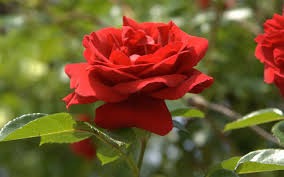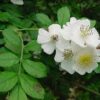Biological Characteristics of Rosa laevigata

Rosa laevigata, commonly known as the Cherokee rose, is a captivating species renowned for its striking white flowers and glossy green leaves. Originating in southern China and Taiwan, it has been widely naturalized in the southeastern United States. This article delves into the biological characteristics of Rosa laevigata, exploring its morphology, growth habits, reproductive biology, and ecological interactions.
#### Morphology
**Leaves:**
Rosa laevigata is a deciduous or semi-evergreen shrub with compound leaves that are typically dark green, leathery, and shiny. Each leaf comprises three leaflets, each leaflet being ovate with finely serrated edges. The leaf arrangement is alternate, contributing to the plant’s lush and dense foliage. The glossy texture of the leaves not only adds to the plant’s aesthetic appeal but also aids in reducing water loss through transpiration, an adaptation beneficial for its survival in various climates.
**Stems and Thorns:**
The stems of Rosa laevigata are robust and woody, often growing into a sprawling or climbing habit. The plant is known for its vigorous growth, with stems that can reach lengths of 3 to 6 meters, often climbing over other vegetation or structures. The stems are typically covered with small, curved thorns that aid in climbing and provide protection against herbivores. These thorns are a notable characteristic, making the plant easily recognizable and adding to its rugged charm.
**Flowers:**
One of the most distinctive features of Rosa laevigata is its large, showy flowers. The blossoms are solitary and measure between 6 to 10 centimeters in diameter. Each flower has five pure white petals that contrast beautifully with the central cluster of golden-yellow stamens. The flowers are fragrant, emitting a sweet scent that attracts pollinators such as bees and butterflies. The blooming period typically occurs in early spring, with flowers appearing before the foliage is fully developed, creating a striking visual impact in the landscape.
**Fruit:**
Following the flowering period, Rosa laevigata produces fruit known as hips. The hips are oblong to pear-shaped, measuring about 2 to 3 centimeters in length, and turn orange to red when ripe. These hips are rich in vitamin C and other nutrients, making them valuable both ecologically and nutritionally. The seeds within the hips are dispersed by birds and other animals that consume the fruit, aiding in the plant’s propagation and spread.
#### Growth Habits
**Growth Form:**
Rosa laevigata exhibits a vigorous and sprawling growth form. It can function both as a groundcover and a climbing shrub, depending on the available support. In the presence of trees, fences, or other structures, it will readily climb, using its thorns to secure itself. This climbing habit allows it to reach sunlight in dense vegetation, while its groundcover form helps stabilize soil and prevent erosion.
**Adaptability:**
This species is highly adaptable to a range of environmental conditions. It can thrive in various soil types, including sandy, loamy, and clay soils, provided they are well-drained. Rosa laevigata is also drought-tolerant once established, making it suitable for regions with sporadic rainfall. Its ability to thrive in both full sun and partial shade further enhances its versatility in different habitats.
**Hardiness:**
Rosa laevigata is hardy in USDA zones 7 through 9. It can withstand temperatures as low as -10 degrees Celsius (14 degrees Fahrenheit), although it may suffer damage in prolonged freezing conditions. In warmer climates, it remains evergreen, providing year-round greenery, while in cooler areas, it may lose its leaves in winter and regrow them in spring.
#### Reproductive Biology
**Flowering and Pollination:**
The flowering period of Rosa laevigata typically begins in early spring and can extend into early summer. The large, white flowers are hermaphroditic, containing both male (stamens) and female (pistils) reproductive organs. Pollination is primarily achieved through insects, with bees being the most common pollinators. The bright yellow stamens and sweet fragrance of the flowers effectively attract these pollinators, ensuring successful reproduction.
**Seed Production and Dispersal:**
After pollination, the flowers develop into hips that mature by late summer to early autumn. Each hip contains multiple seeds encased in a fleshy, nutrient-rich matrix. The primary mode of seed dispersal is endozoochory, where birds and mammals consume the hips and later excrete the seeds, facilitating their spread to new locations. This mode of dispersal is highly effective, allowing Rosa laevigata to colonize a variety of habitats.
**Vegetative Propagation:**
In addition to seed reproduction, Rosa laevigata can propagate vegetatively through runners and root suckers. This ability to produce new plants from existing root systems or stem segments contributes to its vigorous growth and capacity to form dense thickets. Vegetative propagation is particularly advantageous in environments where seedling survival rates are low, ensuring the persistence and expansion of the species.
#### Ecological Interactions
**Role in Ecosystems:**
Rosa laevigata plays a significant role in the ecosystems it inhabits. Its flowers provide nectar and pollen for a variety of pollinators, including bees, butterflies, and other insects. The hips serve as a food source for birds and small mammals, particularly during the winter months when other food sources may be scarce. Additionally, the dense thickets formed by the plant offer shelter and nesting sites for wildlife, enhancing local biodiversity.
**Symbiotic Relationships:**
The plant engages in several symbiotic relationships within its ecosystem. For instance, certain species of ants and aphids have mutualistic interactions with Rosa laevigata. The aphids feed on the plant’s sap, excreting honeydew, which attracts ants. The ants, in turn, protect the aphids from predators, creating a beneficial arrangement for both insects. Moreover, the presence of mycorrhizal fungi in the soil can enhance the nutrient uptake of Rosa laevigata, promoting healthier growth.
**Competitive Dynamics:**
Despite its ecological benefits, Rosa laevigata can exhibit competitive behaviors that impact native plant communities. Its ability to form dense thickets can suppress the growth of surrounding vegetation, reducing biodiversity. In areas where it is considered invasive, this competitive nature necessitates management strategies to control its spread and mitigate its impact on native ecosystems.
#### Conclusion
Rosa laevigata, with its striking flowers, vigorous growth, and ecological interactions, is a remarkable species that captivates botanists and horticulturists alike. Its adaptability and resilience have enabled it to thrive in diverse environments, from its native regions in Asia to its naturalized habitats in North America. Understanding the biological characteristics of Rosa laevigata provides valuable insights into its role in ecosystems, its reproductive strategies, and its interactions with other species. This knowledge is essential for both appreciating the plant’s beauty and managing its presence in various landscapes.
### Biological Characteristics of Rosa laevigata (Part 2)
#### Genetic Characteristics
**Genomic Structure:**
Rosa laevigata is a diploid species, meaning it has two sets of chromosomes, which is typical for most species in the Rosa genus. The diploid chromosome number is 2n = 14. This genetic structure provides a foundation for understanding the plant’s hereditary traits and variations. Recent advancements in genomic sequencing have allowed scientists to map the genome of Rosa laevigata, leading to insights into genes responsible for its unique characteristics such as flower color, fragrance, and disease resistance.
**Genetic Diversity:**
The genetic diversity within Rosa laevigata populations is influenced by both natural and artificial selection. In its native range, genetic diversity is maintained through cross-pollination facilitated by insects. In areas where it has been introduced, human cultivation practices, including selective breeding for desirable traits, have also shaped the genetic makeup of the species. High genetic diversity is crucial for the plant’s adaptability to various environmental conditions and resistance to diseases.
**Hybridization:**
Rosa laevigata has been used in hybridization programs to develop new rose cultivars. Its hardiness and disease resistance make it a valuable genetic resource for breeding. Hybridization efforts often focus on combining the ornamental qualities of Rosa laevigata, such as its large, white flowers, with other rose species to create hybrids with improved aesthetic and horticultural traits. These hybrids can exhibit a blend of characteristics, including varied flower colors, enhanced fragrance, and increased resilience.
#### Physiological Adaptations
**Drought Tolerance:**
Rosa laevigata is well-adapted to withstand periods of drought. Its physiological adaptations include a deep root system that can access water from deeper soil layers and thick, leathery leaves that reduce water loss through transpiration. During dry periods, the plant can enter a state of dormancy, minimizing water usage until favorable conditions return. These adaptations make Rosa laevigata suitable for cultivation in regions with variable rainfall.
**Cold Resistance:**
Although Rosa laevigata thrives in warmer climates, it exhibits a degree of cold resistance that allows it to survive in temperate regions. The plant can endure temperatures as low as -10 degrees Celsius (14 degrees Fahrenheit). This resilience is partly due to its ability to enter dormancy during the winter months, protecting its vital tissues from freezing temperatures. In colder climates, the plant’s leaves may fall off, but it regrows them in the spring, maintaining its growth cycle.
**Pest and Disease Resistance:**
Rosa laevigata is relatively resistant to common rose pests and diseases, such as black spot, powdery mildew, and aphids. This resistance is attributed to the plant’s thick, leathery leaves and robust overall health. Additionally, the presence of thorns provides a physical barrier against larger herbivores. However, it is not entirely immune to all threats. Regular monitoring and appropriate horticultural practices can help manage any pest or disease outbreaks.
#### Ecological Interactions
**Pollinators:**
Rosa laevigata plays a crucial role in supporting local pollinator populations. Its large, fragrant flowers are a rich source of nectar and pollen, attracting a variety of pollinators, including bees, butterflies, and beetles. These interactions not only facilitate the plant’s reproductive success but also contribute to the health and diversity of the pollinator community. In turn, these pollinators aid in the fertilization of other plants in the ecosystem, promoting overall biodiversity.
**Seed Dispersers:**
The fruit of Rosa laevigata, known as hips, serves as a food source for birds and mammals. Species such as thrushes, finches, and squirrels consume the hips, aiding in seed dispersal through their droppings. This endozoochory (seed dispersal via ingestion by animals) ensures that the seeds are spread over a wide area, promoting genetic diversity and the colonization of new habitats. The nutritional content of the hips also provides essential sustenance for wildlife, especially during the winter months when other food sources are scarce.
**Soil and Water Conservation:**
Rosa laevigata contributes to soil and water conservation through its extensive root system, which stabilizes the soil and reduces erosion. This is particularly beneficial in areas prone to soil degradation or on slopes where erosion is a significant concern. The plant’s foliage also helps in maintaining soil moisture by providing ground cover that reduces evaporation rates. In riparian zones, Rosa laevigata can enhance bank stability and improve water quality by filtering runoff and trapping sediments.
#### Conservation and Environmental Impact
**Conservation Status:**
In its native range, Rosa laevigata is not considered endangered. However, its conservation status in introduced regions varies. In the southeastern United States, it is naturalized and widely distributed. Conservation efforts in these areas focus on managing its spread to prevent it from becoming invasive and displacing native plant species. In its native habitats, conservation priorities include preserving genetic diversity and protecting natural populations from habitat loss and degradation.
**Invasive Potential:**
While Rosa laevigata is valued for its ornamental and ecological benefits, it can exhibit invasive behavior in non-native regions. Its ability to form dense thickets and outcompete local vegetation poses a threat to native biodiversity. In areas where it is considered invasive, management strategies include mechanical removal, controlled burns, and the application of herbicides to control its spread. Public awareness and education on the responsible planting and management of Rosa laevigata are also crucial in mitigating its invasive impact.
**Habitat Restoration:**
Rosa laevigata can be used in habitat restoration projects due to its hardiness and ability to stabilize soils. It is particularly useful in restoring degraded landscapes and improving habitat quality for wildlife. However, its use must be carefully managed to ensure that it does not become invasive. In restoration contexts, it is often planted in combination with native species to enhance biodiversity and create resilient ecosystems.
#### Future Research Directions
**Genetic Improvement:**
Future research on Rosa laevigata aims to explore its genetic potential for breeding and hybridization. By identifying and isolating genes responsible for desirable traits such as disease resistance, drought tolerance, and flower characteristics, scientists can develop improved cultivars. These cultivars can benefit both ornamental horticulture and ecological restoration efforts, providing plants that are not only aesthetically pleasing but also resilient and adaptable.
**Ecological Studies:**
Ongoing ecological studies focus on understanding the interactions between Rosa laevigata and its environment. Research on its role in supporting pollinators, seed dispersers, and soil health can provide valuable insights into its ecological contributions and potential impacts. Such studies inform conservation strategies and management practices, ensuring that Rosa laevigata is utilized in ways that promote ecosystem health and biodiversity.
**Climate Change Adaptation:**
As climate change alters environmental conditions, research on the adaptability of Rosa laevigata becomes increasingly important. Studies on its response to changing temperatures, precipitation patterns, and extreme weather events can help predict its future distribution and ecological impact. By understanding how Rosa laevigata adapts to climate change, scientists can develop strategies to enhance the resilience of ecosystems and mitigate the adverse effects of global climate shifts.
#### Conclusion
Rosa laevigata, with its striking flowers, robust growth, and diverse ecological interactions, is a plant of significant biological and cultural importance. Its adaptability and resilience have enabled it to thrive in a variety of environments, from its native regions in Asia to its naturalized habitats in North America. Understanding the biological characteristics of Rosa laevigata, from its genetic traits to its ecological roles, provides a comprehensive view of this remarkable species. As we continue to study and manage Rosa laevigata, it remains a symbol of nature’s beauty and adaptability, offering insights into the intricate connections between plants and their environments.

